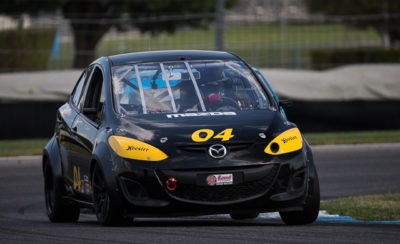Mark Brakke was looking for a change from his E Production Miata; he found it in an H Prod Mazda2
In a class once filled with tiny-engined British roadsters, the newer sedans are taking over SCCA’s H Production – they generally have more power and are sometimes easier to build thanks to Limited Prep rules. A couple of makes have been extremely popular, but some racers look for something different, something from a brand they love or something they think will give them an edge.
Mark Brakke had been racing an E Production Miata with his brother, two-time SCCA national champion Jon Brakke, but it was time for a change. “I enjoy new projects more than maintaining old ones, so I thought it was time to build a new car,” Mark explains. “I looked at what was going on in H Production, and it looked to me like it was starting to get a little more popular again. I thought, ‘Well, maybe I’ll try building and driving a front-wheel-drive car.’”
So, for the first time in 40 years, Brakke is not driving a front-engine, rear-wheel-drive car. Instead, it’s Mazda2, and he’s had some challenges in both learning to race a front-wheel-drive car and in developing it.
“We had a few wiring issues that were difficult to track down, and we also discovered that if you put too much negative camber in the front, you can get the universal joints to run at the end of their design range and they can end up failing. We had two axle failures this year and then figured out the reason was because we had enough negative camber from the adjustable lower control arms that it had stretched the axle out too far.”
Brakke solved that with a spacer, but the next step will be to build some camber plates to get the camber from the top of the suspension rather than getting it all from the bottom of the coilover shocks. The rear also has coilovers, and the car sits lower. The Mazda2 is built as a Limited Prep car in the class, meaning the head has minimal porting, it must use the stock throttle body and stock manifold, and has a limited compression ratio.
Brakke, who started 15th and finished 13th in a 44-car field at the Runoffs, says the car is getting it done in the corners, while it’s limited on the top end. In driving the car, getting used to the front-wheel drive has been a challenge.
“With rear-wheel drive, you get into the corner a little bit hot and the car’s moving sideways, you just get off the throttle and let it slow down a little bit,” Brakke explains. “As long as you weren’t outrageously too fast, that’s all you need to get the car back underneath you. With front-wheel drive, if you get into the corner hot and the car’s going sideways and you do a total lift off the gas, the front end bites better, the back is still at the limit and the car just does a snap spin on you. So my brain for decades has been saying, ‘If it gets loose, lift.’ Now my brain has to say, ‘If it gets loose, stay in it. Drive your way out.’”


 ACCESSIBILITY
ACCESSIBILITY